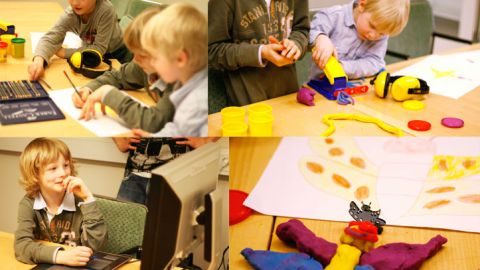The Last Present You’ll Ever Have to Buy Your Kid

What’s the Big Idea?
How well did you do with your Christmas shopping this year? Did your daughter’s face light up when she unwrapped Elmo? Did you delight your husband with Skyrim?
According to Kevin Ryan, CEO of the online luxury shopping website Gilt Groupe, the best Christmas gifts are personalized. They are either truly personal for the person you are giving it to or “memorable because it is coming from me,” the Silicon Alley star told Big Think.
So how do you personalize a gift? In the olden days this might have meant knitting a scarf for your daughter or whittling a toy sword for your son. But why spend time knitting? That’s what robots are for. Like the Picaxe Electronic Knitting Machine. Check it out:
Thanks to advances in 3D printing, you will soon be able to manufacture a wide array of gifts right in your own home. Think of it as a high tech Santa’s workshop, without the elves. 3D printing has been around for over 20 years, but recently the cost has dropped considerably. One notable example is Origo, a 3D printer designed for 10 year-old kids and “exceptional adults.”
While Origo is not yet on the market, its developers describe it as a user-friendly appliance that is “as big as three Xbox 360s and as expensive as three Xbox 360s” — about $800. In addition to the price and size of the printer, Origo is a promising product because it utilizes 3Dtin, an online application that bypasses the design constraints of 3D printing so that “anyone can design whatever they want in minutes.” This means that your 10 year-old will no longer have to write a letter to Santa. Instead, your kid will be able to dream up a design, draw it, and print it.
Here’s what Origo looks like:
“I’m an appliance, like a toaster or a microwave. Only I’m purple and make your stuff.”
While you may have to wait 18 months to purchase Origo, right now you can buy a desktop three-dimensional printer for about $1,000. These are often used by schools to design and print objects for educational projects. A higher-end professional-grade machine can cost over $60,000, and enables a consumer to produce retail-quality products like customized jewelry, hearing aids, lighting fixtures and customized doorknobs. Production materials can cost anywhere from two to eight dollars per a cubic inch.
“Think about action figures—people could actually print their Second Life characters,” says Cathy Lewis, Vice President of Global Marketing at 3D Systems. “Think about when you’re at home and you lose the pieces to a puzzle or a board game. In the future you’ll just be able to make replacements.”
Other examples of 3D printers include Shapeways, which implements 3D printing technology to manufacture and sell mass customized products online. You can also buy a 3D printer that makes “almost anything” up to 4″x4″x6″ from MakerBot.
What’s the Significance?
As Parag and Ayesha Khanna point out, the exploding 3D printing industry will create many winners (designers) and losers (China’s manufacturing economy):
Designers will become rockstars; after all, apart from a one-time payment for the printer and periodic investment in materials, you will spend the bulk of your money buying the blueprint of an object. For example, when you purchase a toy on Amazon, you will in fact buy and download an encrypted design document from which you can print out the toy at home. We’ll probably see a rise in small Mom and Pop stores that can design beautiful personalized objects for people now that the cost of producing just a few items of a kind will be extremely cheap. If you’re considering a career change, desktop design may be a good field to consider.
Image courtesy of Shutterstock
Follow Daniel Honan on Twitter @Daniel Honan
Andrew Dermont also contributed to this article.





